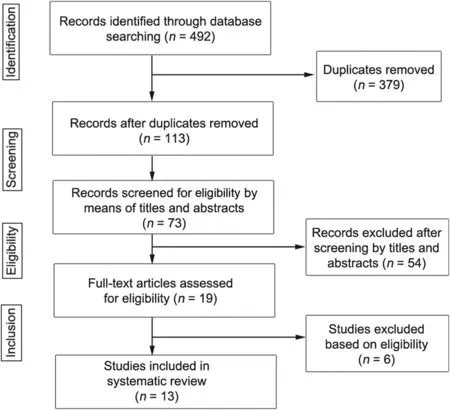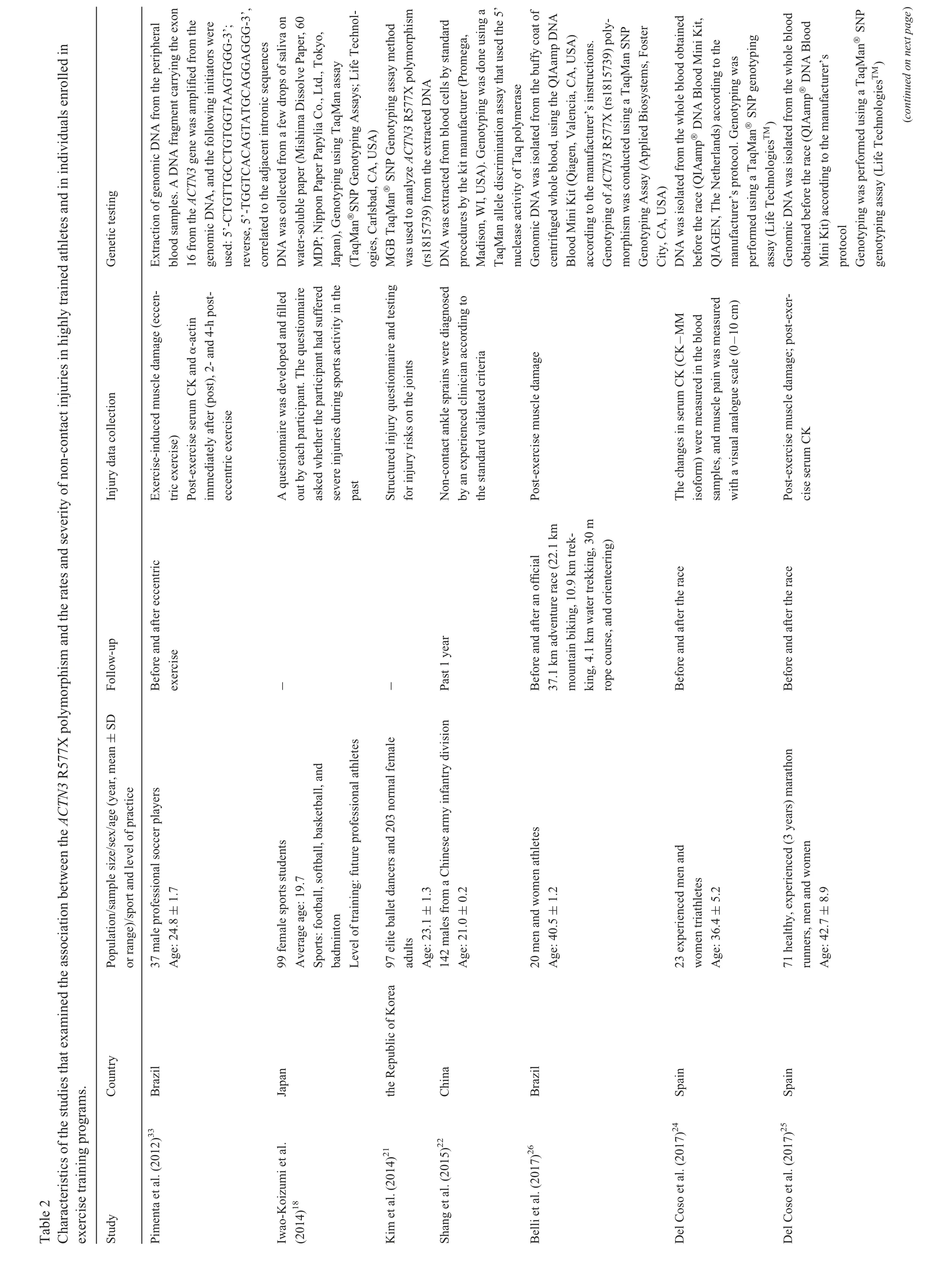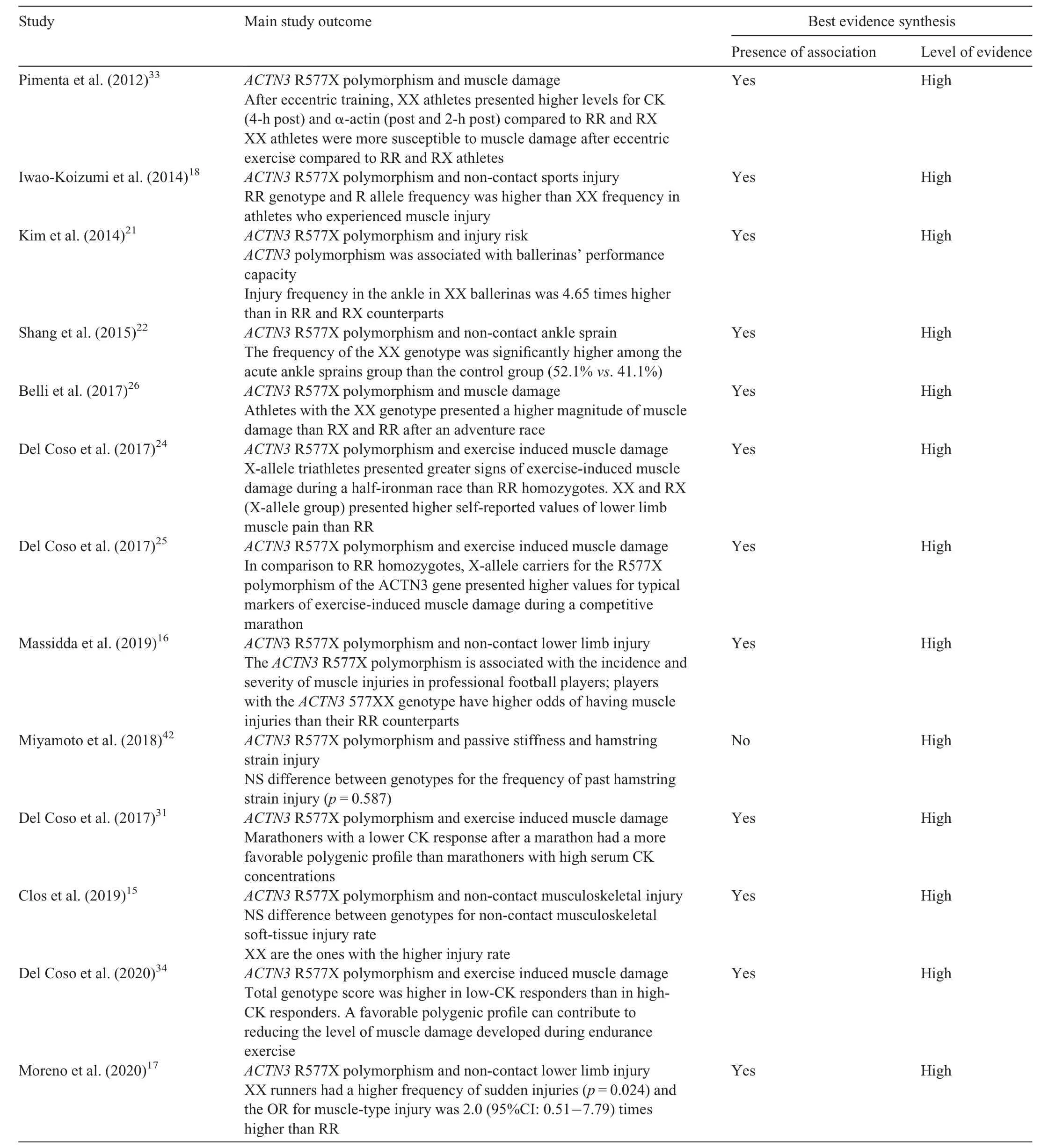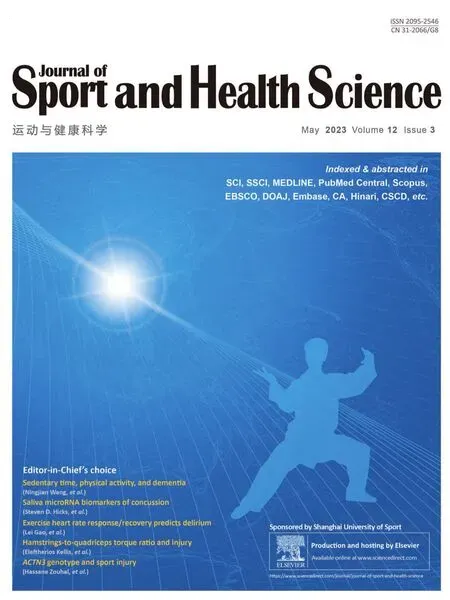Association between ACTN3 R577X genotype and risk of non-contact injury in trained athletes:A systematic review
Hassan Zoual *,Juan Dl Coso ,Ayyappan Jayavl ,Clair Tourny ,Guillaum Ravé ,Nial Jali ,Cain C.T.Clark,Bnjamin Bartélémy,Antony C.Hakny,Arraou Bn Arraman
a M2S(Laboratoire Mouvement,Sport,Santé)-EA 1274,Department of Sport Sciences,University of Rennes,Rennes F-35000,France
b Rey Juan Carlos University,Centre for Sport Studies,Madrid 28032,Spain
c SRM College of Physiotherapy,SRM Institute of Science and Technology,SRM Nagar,Kattankulathur 603203,India
d Department of Sport Sciences,University of Rouen,Mont Saint Aignan,CETAPS EA 3832,F-76821,France
e Toulouse Football Club,Toulouse 31000,France
f Higher Institute of Sport and Physical Education,Ksar-Said,University of Manouba,Tunis 2010,Tunisia
g Centre for Intelligent Healthcare,Coventry University,Coventry CV1 5FB,UK
h Department of Exercise&Sport Science,Department of Nutrition,University of North Carolina,Chapel Hill,NC 27514,USA
Abstract Purpose: The aim of this study was to review,systematically,evidence concerning the link between the ACTN3 R577X polymorphism and the rates and severity of non-contact injuries and exercise-induced muscle damage in athletes and individuals enrolled in exercise training programs.Methods: A computerized literature search was performed in the electronic databases PubMed,Web of Science,and SPORTDiscus,from inception until November 2020.All included studies compared the epidemiological characteristics of non-contact injury between the different genotypes of the ACTN3 R577X polymorphism.Results: Our search identified 492 records.After the screening of titles,abstracts,and full texts,13 studies examining the association between the ACTN3 genotypes and the rate and severity of non-contact injury were included in the analysis.These studies were performed in 6 different countries(Spain,Japan,Brazil,China,the Republic of Korea,and Italy) and involved a total participant pool of 1093 participants.Of the studies,2 studies involved only women,5 studies involved only men,and 6 studies involved both men and women.All the studies included were classified as highquality studies(≥6 points in the Physiotherapy Evidence Database(PEDro)scale score).Overall,evidence suggests there is an association between the ACTN3 R577X genotype and non-contact injury in 12 investigations.Six studies observed a significant association between ACTN3 R577X polymorphism and exercise induced muscle damage:2 with non-contact ankle injury,3 with non-contact muscle injury,and 1 with overall non-contact injury.Conclusion: The present findings support the premise that possessing the ACTN3 XX genotype may predispose athletes to a higher probability of some non-contact injuries,such as muscle injury,ankle sprains,and higher levels of exercise-induced muscle damage.
Keywords: α-actinin-3 deficiency;Athletic performance;Exercise-related injury;Muscle injury;Single nucleotide polymorphism
1.Introduction
The protein α-actinin-3 is a structural component of the Z-disc encoded by theACTN3gene.The main role of α-actinin-3 is anchoring actin thin filaments to assist in maintaining the myofibrillar array,which contributes to regulating muscle length and tension during contraction.1Interestingly,α-actinin-3 is expressed only in fast muscle fibers (all fastglycolytic type 2b fibers and 50% of fast oxidative type 2a fibers),2suggesting a specific function for powerful and fast muscle contractions.A common genetic variant in theACTN3(rs1815739,also known as the R577X polymorphism)leads to the replacement of an arginine (R) with a premature stop codon(X) at amino acid 577.Consequently,individuals with theACTN3XX genotype are α-actinin-3 protein deficient due to the lack of protein expression.In contrast,homozygous individuals for the R allele (RR genotype) or heterozygote individuals (RX genotype) express α-actinin-3,although recently it has been found that the capacity to express α-actinin-3 is dose-dependent for RRvs.RX individuals.3The deficiency of α-actinin-3 does not entail any disease or clinical condition but has been demonstrated to produce some potentially negative phenotypes in humans,such as lower muscle strength,4,5reduced muscle volume,6,7impaired capacity to tolerate the strain produced by explosive muscular actions,8and/or an association with decreased bone mineral density.9
In athletes,several investigations have confirmed that α-actinin-3 deficiency due to theACTN3XX genotype may negatively influence sprint and power performance.10Lower performance in sport disciplines requiring near-to-maximal production of strength or power has been associated with decreased capacity of the ability of muscle fibers to produce powerful contractions in the absence of α-actinin-3.7This notion is supported by several investigations that found a higher occurrence of theACTN3RR variant in elite sprint/power athletes when compared with nonathletes.1In contrast,a higher-than-expected frequency of theACTN3XX genotype has been found in some groups of elite endurance athletes,9,11although the overrepresentation of the XX genotype has not been replicated in other cohorts of elite athletes.12,13Collectively,the information obtained from studies investigating the frequency of the differentACTN3genotypes in cohorts of elite athletes points toward a negative influence of the XX genotype on elite sprint/power-based exercise (hence,a positive influence of the R allele on this type of exercise) with little or no effect of the XX genotype on endurance-based exercise.
In addition to performance,the absence of α-actinin-3 has been linked to a higher probability of injury14in several sport and exercise scenarios.For example,soccer (football) players with theACTN3XX genotype suffered a higher incidence of non-contact muscle injuries when compared to players with the RR or the RX genotype.15,16A higher probability of muscle-type injuries was also found in XX compared to RR runners.17On the other hand,at least 1 investigation has reported that athletes with the RR or the RX genotype had an increased risk of muscle injury when practicing various sport activities.18Additionally,there is an increase in passive hamstring stiffness in R-allele individuals compared to XX counterparts,19although the link between muscle stiffness and increased muscle injury risk has not yet been established.14,20The most consistent specific findings posit a link between the XX genotype and ankle injuries21-23and higher levels of exercise-induced muscle damage.24-26These associations suggest a negative impact of α-actinin-3 deficiency on muscle and ligament capacity to endure the forces generated during exercise and point toward an increased susceptibility to contraction-induced damage.8,9Despite the extant literature indicating an influence of theACTN3genotype on exerciserelated non-contact injuries,there is no previous investigation,to our knowledge,that has systematically reviewed the influence of theACTN3R577X polymorphism on non-contact injuries.Hence,the aim of this investigation was to review evidence systematically concerning the link between theACTN3R577X polymorphism and the rates and severity of non-contact injuries and exercise-induced muscle damage in athletes and individuals enrolled in exercise-training programs.
2.Methods
2.1. Eligibility criteria
This systematic review was conducted in accordance with the Preferred Reporting Items for Systematic Reviews and Meta-Analyses (PRISMA) statement.27Only studies that examined the link between theACTN3R577X polymorphism and the rates or severity of non-contact injuries in individuals who were at any level/sex/age and currently participating in a sport or exercise-training program were included.The following inclusion criteria were established for studies of this topic (Table 1).The studies (1) were available in peerreviewed journals;(2)involved participants aged ≥14 years;(3)included trained athletes (frequency of training ≥5 times/week)and individuals enrolled in exercise training programs (i.e.,nonathletes);(4) used validated methods for the characterization of injury epidemiology (e.g.,injury severity,occurrence and incidence);(5) obtained epidemiological data about noncontact injuries developed during sport competitions and exercise practice;and (6) full text available in English.Studies were excluded if they (1) did not contain an experiment study design with the original data,such as books,systematic or narrative reviews,case studies,or opinionpieces;(2) did not meet the minimum requirements to classify the sample as exercisers (frequency of training <3 times/week);or (3) were not written in English.

Table 1 Inclusion criteria according to the Population,Intervention,Comparison,Outcomes and Study(PICOS)approach.
2.2. Literature search strategy
Literature searches were conducted in 3 electronic databases including PubMed,Web of Science,and SPORTDiscus,from inception until November 2020.No year restriction was used for the search strategy,in an effort to obtain all studies on the topic.The following key terms (and synonyms searched for by the MeSH database) were included and combined using the operators “AND”,“OR”,“NOT”: ((Alpha-actinin-3 OR ACTN3) OR (“ACTN3 gene” OR “ACTN3 R577X polymorphism” OR “ACTN3 R577X” OR “ACTN3 R577R” OR“ACTN3 577XX genotype*”OR“ACTN3 577RR genotype*”OR“ACTN3 577RX genotype*”)AND(“injuries”OR“injury”OR“muscle injury*”OR“non-contact injury”OR“strain”OR“soreness*” OR “sprain*” OR “contusion” OR “fracture”OR “dislocation” OR “concussion”) AND (correlation study OR association OR relationship)).The references used in the identified studies were searched as well,in order to identify additional relevant research papers.The search for published studies was independently performed by 2 authors (AJ and ABA),and disagreements were resolved through discussion.
2.3. Study selection
The screening and study selection were performed by 2 authors based on the above-mentioned inclusion and exclusion criteria.If the title and abstract of the article showed any potential relevance in terms of assessing the influence of theACTN3genotype on the rates and severity of non-contact injuries,the full text was examined.A third author (HZ) was consulted if the 2 investigators (AJ and ABA) responsible for the study selection were not able to reach an agreement on the inclusion of an article.Fig.1 depicts the details of the studyselection methodology.

Fig.1.Selection of research articles (n=13) included in this systematic review using the recommendations in the Preferred Reporting Items for Systematic Reviews and Meta-Analyses statement.26
2.3.1.Data extraction
Once the inclusion/exclusion criteria were applied,data extraction was conducted to collect information about participants,intervention,comparisons,outcomes,and study design(PICOS) following PRISMA methodology.The following relevant data from each study were extracted: study details(author,year of publication,country,and duration of followup),study population(sample size,age,and participants’sex),sport or main exercise activity performed by the participants,the method used to determine the genotyping ofACTN3R577X (rs1815739),injury definition,workload (external and internal load parameters),and measures of association (i.e.,relative risk (RR) or odds ratio (OR).Where possible,these associations were extracted directly from the original article.For articles in which this information was not present,associations were calculated using raw data,if available.Load parameters were classified as external or internal based on the International Olympic Committee consensus statement on load in sport and risk of injury.28
2.3.2.Quality assessment
The methodological quality of the included studies was assessed using the Physiotherapy Evidence Database (PEDro)scale.29A cut-off point of 6 points in the PEDro scale was used to discriminate high-quality studies,and only studies with scores above this threshold were considered for the systematic review.26Two authors (AJ and ABA) independently assigned a score to each study using the PEDro scale,and disagreements were resolved by consulting a third researcher(HZ).
3.Results
3.1. Study selection and description of the included studies
Our initial search identified 492 records(Fig.1),and after the screening of titles,abstracts,and full texts,respectively,13 studies were included in our final analysis.Accordingly,the characteristics of the participants,the follow-up periods,the injury definitions,and the methods used to determine the genotyping ofACTN3R577X (rs1815739) polymorphism are shown in Table 2.These studies were performed in 6 different countries (Spain,Japan,Brazil,China,the Republic of Korea,and Italy),involving a total participant pool of 1093 participants,where 20 represents the lowest number and 257 the highest number of participants within the studies.Two studies involved only women,5 studies involved only men,and 6 studies involved both men and women.All the studies included were classified as high-quality studies (≥6 in the PEDro scale score)(Table 3).

3.2. Evaluation of the effects of ACTN3 R577X genotype on non-contact injuries
The results of best evidence synthesis of the effects ofACTN3R577X genotype on non-contact injuries are presented in Table 4.For 12 studies,12-15,17,18,20-22,27,29,30evidence existed of an association between theACTN3R577X genotype and non-contact injury,and for the 1 remaining study,no effect was observed.19From the total,6 studies observed a significant association between theACTN3R577X polymorphism and exercise-induced muscle damage,24-26,31-332 studies observed association betweenACTN3R577X polymorphism and noncontact ankle injury,21,22and 1 study observed association with non-contact sports injury (i.e.,muscle strain and ligament rupture).18Additionally,2 studies17,34observed significant associations betweenACTN3R577X polymorphism and non-contact lower-limb injury,and 1 study with non-contact musculoskeletal injury.15Only 1 study reported no significant association betweenACTN3R577X polymorphism and passive stiffness or hamstring strain injury(Table 4).19

Table 4 Results of best evidence synthesis of association between ACTN3 R577X genotype and non-contact injuries.
4.Discussion
Characterizing the influence of theACTN3R577X genotype on exercise-related sport injuries is pertinent because theACTN3XX genotype,which produces α-actinin-3 deficiency,has been repeatedly associated with a reduction in sports performance in sprint and power-based disciplines.35-37The main outcomes of this investigation indicate that most studies of the effect ofACTN3R577X polymorphism on injury epidemiology indicate an association of the XX genotype with a deleterious effect on injury,expressed either by increased incidence or severity,as compared to RX and RR genotypes.However,current evidence suggests that the higher likelihood of exercise-related injury in XX athletes is specific to muscle injury,ligament injury,and an exacerbation of muscle damage.It can be concluded that possessing theACTN3XX genotype may predispose athletes to a higher probability of muscle and ligament injury during exercise.The evidence linkingACTN3genotype and injury epidemiology is still emerging,so it is premature to recommend the determination of athletes’ACTN3genotype for the prediction of injury risk.
4.1. Overall rate of injury
In the studies investigating all types of non-contact exerciserelated injuries in athletes,the evidence indicates a higher injury incidence in RR individuals(defined as those possessing the R allele) when compared to XX individuals.17,18Iwao-Koizumi et al.18found that in female athletes training to become professional athletes,those with the R allele had a 2.52-fold higher likelihood of suffering a severe injury than did those with the X allele.18Similarly,Moreno et al.17found that among amateur runners preparing for a marathon,those with the RR genotype had a 1.79-fold higher likelihood of suffering a running-related injury when compared to their XX counterparts,whereas the likelihood of injury increased to 1.93 when comparing RR and RX athletes.Injury incidence in thesemarathon runners tended to be higher in RR runners;overall injury incidence was not different in phenotypes(2.78 injuries/1000 h of running) and in RX runners (1.65 injuries and 1.94 injuries/1000 h of running,respectively),although this difference was not statistically significant.The higher overall injury incidence in RR athletes,despite the ability to fully express α-actinin-3 in their fast-type muscle fibers,3may be related to other phenotypes found in RR athletes.RR athletes habitually present higher levels of muscle strength and power than their XX counterparts,38,39which may lead to sport-specific actions with a greater degree of speed/power.39In fact,this is one of the assumptions that may explain the higher frequency of RR athletes participating in strength-and power-based sports.8RR athletes may have a lower range of motion and muscle flexibility because lower-ankle dorsiflexion7and lower-trunk flexibility40,41have been found in RRvs.RX-XX genotypes.A greater volume or magnitude of sport-specific actions performed at higher intensity,coupled with reduced joint mobility,may explain the higher injury rates of RR athletes compared to RX-XX athletes.Nevertheless,the studies of this topic are scant,and the evidence is still not sufficient to link clearly theACTN3 RR genotype with a higher injury rate.Future investigations are needed to affirm whether RR individuals are more prone to overall sport-related injuries,particularly in high-intensity sports.
To summarize:When accounting for all types of injury,RR athletes may be more prone to sport-specific injury because the presence of α-actinin-3 in their muscles likely entails the production of more forceful and powerful contractions.
4.2. Muscle injury and exercise-induced muscle damage
4.2.1.Muscle injury
When investigating only non-contact muscle-type injuries,the evidence indicates that XX athletes are more prone to this specific type of injury.For example,Massidda et al.16found that,among male professional football players,the odds were 2.66 times higher for those with the XX genotype to suffer a muscle injury than for their RR counterparts,with no difference between RR and RX football players.Additionally,the XX players had a 2.13-fold higher probability of having a severe injury compared with RR players,despite similar training exposure among genotypes.Similar results were shown by Clos et al.15in a sample of professional football players;those with the XX genotype presented a 1.84-fold greater likelihood of suffering a muscle-type injury,although there was no difference in severity.15In a sample of amateur marathoners,Moreno et al.17showed that XX runners presented a 2.0-fold greater likelihood of muscle-type injuries when compared to RR runners.This was evident only for muscle-type injuries because the probability of the overall injury(i.e.,including all types of injuries)was higher in RRvs.XX individuals.On the other hand,Miyamoto et al.42did not find any effect of theACTN3genotype on the frequency of hamstring strain injuries in a sample of young male athletes.However,this investigation was based only on a specific body location,and that could have reduced the likelihood of finding differences among the genotypes.Collectively,these investigations indicate that α-actinin-3 deficiency,due to homozygosity in theACTN3R577X polymorphism,may entail a higher probability of non-contact muscle injuries.Del Coso et al.7,10proposed that this could be explained by the lower capacity of α-actinin-3-deficient muscle fibers to endure physical stress.Interestingly,α-actinin-3 deficiency is habitually compensated for by a higher amount of α-actinin-2.43The current data concerning differing muscle-injury incidence among genotypes indirectly suggests that the role of α-actinin-3 is different from the role of α-actinin-2,which may explain why these muscle sarcomeric isoforms of α-actinin have remained through evolution;however,further work to elucidate the veracity of this claim is warranted.
4.2.2.Exercise-induced muscle damage
Additional evidence suggesting that α-actinin-3 deficiency,due to theACTN3XX genotype,results in muscle fibers with less capacity to endure stress during exercise was found in those investigations that assessed muscle damage.When compared to RR counterparts,carriers of theACTN3X allele presented higher values of indirect markers of muscle damage,such as(1)reduced jump height;24,25(2) postexercise or pre-to postexercise changes in serum creatine kinase or myoglobin concentrations;33,39and (3) self-reported muscle-pain values.25The results are similar when comparing XX athletes to those with the R allele,26suggesting that the R allele may have a dose-response effect,playing a protective role to prevent exercise-induced muscle damage (i.e.,RR >RX >XX).Higher markers of exercise-induced muscle damage in XX individuals have also been found in some non-athletic populations,44although this is not always the case.45These outcomes indicate that α-actinin-3 has a positive role in modulating the capacity of muscle to endure potentially damaging contractions during exercise,37whereas α-actinin-3 deficiency due to homozygosity in theACTN3R577X polymorphism may entail a higher probability of muscle injury/muscle damage during exercise.Of note,ACTN3is one of several genes involved in the response to exercise-induced muscle damage;the capacity of skeletal muscle to endure the physical stress imposed by exercise may be associated with possessing favorable genotypes in several genes.24,32
To summarize:When accounting for muscle-specific injury and exercise-induced muscle damage,α-actinin-3 deficiency resulting from homozygosity in the null-X allele of theACTN3gene was associated with a higher incidence of injury as well as with injuries of higher severity.
4.3. Ligament injury
In the current review,2 independent investigations determined that XX individuals are more prone to ligament injury,specifically in the ankle.21,22According to the odds ratio analysis performed by Kim et al.,21elite ballerinas with the XX genotype had a 4.7-fold higher risk of ankle injury than the RRand RX-genotyped ballerinas,although this greater risk of injury was not present in other body locations,such as the knee,pelvis,or back.In an investigation done by Shang et al.,22the frequency of the XX genotype in lance corporals with ankle sprain was higher than that in a control group without this type of injury.Interestingly,this investigation revealed that the XX genotype is associated not only with the likelihood of injury but also with the severity;the presence of the X allele resulted in greater gravity of an injury(e.g.,ankle sprains from Grade I to Grade III).As previously suggested,36the higher likelihood of ligament injury in α-actinin-3-deficient athletes might be related to a dysfunction in the capacity of the muscle to hold the joint during sport-specific actions rather than to an effect of the XX genotype on the characteristics of the ligament.This is because,to date,there is no evidence suggesting thatACTN3R577X polymorphism has any impact on ligament tissue.XX athletes may be more prone to ligament injury during exercise,although this evidence exists for the ankle joint only.
To summarize: Further replication investigations are needed to confirm this finding and to expand the perspectives to other joints.
5.Conclusion
The current systematic review indicates that most studies of the effect of theACTN3gene relative to injury epidemiology in athletes have found an association between theACTN3genotype and injury risk and severity.Specifically,possessing theACTN3XX genotype may predispose athletes to a higher probability of some non-contact injuries,such as muscle injury,ankle sprains,and higher levels of exercise-induced muscular damage.Notwithstanding this interesting finding,we acknowledge that this conclusion is based on a limited number of studies(n=13).Evidence is still emerging and,thus far,has been obtained from studies with very heterogeneous samples of athletes,with different methodologies used to quantify injury incidence and epidemiology and,in most cases,with low or small samples sizes,all of which can complicate interpretations of data.46Despite the preliminary evidence for the notion that the XX genotype might be associated with a higher risk of injury issues,the common view is that there is no current clinical application for genetic testing in the area of exercise prescription and injury prevention.47,48The evidence herein suggests that this may not be the case.Future research into this topic is warranted in order to produce more convincing evidence-based approaches to either support or refuteACTN3genotyping for injury prevention.
Authors’contributions
HZ and JDC were involved in the conceptualization of the study,data analysis,and the writing of the manuscript;AJ,CT,GR,NJ,CCTC,BB,and ABA were involved in the data assessment,data analysis,and the writing of the manuscript;ACH was involved in the writing of the manuscript.All authors have read and approved the final version of the manuscript,and agree with the order of presentation of the authors.
Competing interests
The authors declare that they have no competing interests.
 Journal of Sport and Health Science2023年3期
Journal of Sport and Health Science2023年3期
- Journal of Sport and Health Science的其它文章
- Impact loading in female runners with single and multiple bone stress injuries during fresh and exerted conditions
- Are EPB41 and alpha-synuclein diagnostic biomarkers of sport-related concussion?Findings from the NCAA and Department of Defense CARE Consortium
- Factors and expectations influencing concussion disclosure within NCAA Division I athletes:A mixed methodological approach
- Effects of contact/collision sport history on gait in early-to mid-adulthood
- Refinement of saliva microRNA biomarkers for sports-related concussion
- Lacrosse-related injuries in boys and girls treated in U.S.emergency departments,2000-2016
